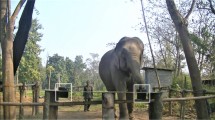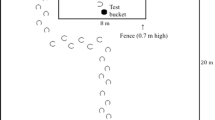Abstract
Teaching is a powerful form of social learning, but there is little systematic evidence that it occurs in species other than humans. Using long-term video archives the foraging behaviors by mother Atlantic spotted dolphins (Stenella frontalis) were observed when their calves were present and when their calves were not present, including in the presence of non-calf conspecifics. The nine mothers we observed chased prey significantly longer and made significantly more referential body-orienting movements in the direction of the prey during foraging events when their calves were present than when their calves were not present, regardless of whether they were foraging alone or with another non-calf dolphin. Although further research into the potential consequences for the naïve calves is still warranted, these data based on the maternal foraging behavior are suggestive of teaching as a social-learning mechanism in nonhuman animals.



Similar content being viewed by others
Notes
One mother, Little Gash, was observed foraging without her calf present both as an adult and as a juvenile. When group means were compared including Little Gash there were no significant differences between adults and juveniles for either chase latencies, t (8) = 0.05, P = 0.96, or body-orienting movements, t (8) = 0.41, P = 0.69. Both the mean chase latencies, M A = 3.67 and M J = 6.89, and mean number of body-orienting movements, M A = 0.5 and M J = 1.0, for Little Gash were comparable as an adult and as a juvenile.
It is important to note that research in captivity (Pack and Herman 1995) has demonstrated the ability of dolphins to perceive and recognize objects through either vision or echolocation. In addition, their perceptions are readily shared or integrated across the senses, regardless of which modality the dolphin originally perceived the external stimuli. However, the sounds emitted from the dolphins were not measured in the present study, but should be looked at in future research in order to determine what sensory information the calf is receiving.
References
Bering JM (2001) Theistic percepts in other species: can chimpanzees represent the minds of non-natural agents? J Cogn Cult 1:107–137
Bering JM, Povinelli DJ (2003) Comparing cognitive development. In: Maestripieri D (ed) Primate psychology. Harvard University Press, Cambridge, pp 205–233
Bjorklund DF, Bering JM (2003) Big brains, slow development, and social complexity: the developmental and evolutionary origins of social cognition. In: Brüne M, Ribbert H, Schiefenhövel W (eds) The social brain: evolutionary aspects of development and pathology. Wiley, New York, pp 133–151
Bjorklund DF, Yunger JL, Bering JM, Ragan P (2002) The generalization of deferred imitation in enculturated chimpanzees (Pan troglodytes). Anim Cogn 5:49–58
Boesch C (1991) Teaching in wild chimpanzees. Anim Behav 41:530–532
Boesch C (1993) Toward a new image of culture in chimpanzees. Behav Brain Sci 16:514–515
Boesch C, Tomasello M (1998) Chimpanzee and human cultures. Curr Anthropol 39:591–614
Caro TM, Hauser MD (1992) Is there teaching in nonhuman animals? Q Rev Biol 67:151–174
Greenfield P, Maynard A, Boehm C, Schmidtling EY (2000) Cultural apprenticeship and cultural change: tool learning and imitation in chimpanzees and humans. In: Parker ST, Langer J, McKinney ML (eds) Biology, brains, and behavior: the evolution of human development. School of American Research Press, Santa Fe, pp 237–277
Guinet C, Bouvier J (1995) Development of intentional stranding hunting techniques in killer whale (Orcinus orca) calves at Crozet Archipelago. Canadian Journal of Zoology 73:27–33
Herman LM (2002) Vocal, social, and self-imitation by bottlenosed dolphins. In: Nehaniv C, Dautenhahn K (eds) Imitation in animals and artifacts. MIT Press, Cambridge, pp 63–108
Herman LM, Abichandani SL, Elhajj AN, Herman EYK, Sanchez JL, Pack AA (1999) Dolphins (Tursiops truncatus) comprehend the referential character of the human pointing gesture. J Comp Psychol 113:347–364
Herzing DL (1996) Vocalizations and associated underwater behavior of free-ranging Atlantic spotted dolphins, Stenella frontalis, and bottlenose dolphins, Tursiops truncatus. Aquat Mamm 22:61–79
Herzing DL (1997) The life history of free-ranging Atlantic spotted dolphins (Stenella frontalis): age classes, color phases an female reproduction. Mar Mamm Sci 13:576–595
Herzing DL (2005) Transmission mechanisms of social learning in dolphins: underwater observations of free-ranging dolphins in the Bahamas. In: Delfour F (ed) Autour de L’ethologie et de la cognition animale. Presses Universitaires de Lyon, Lyon, pp 185–194
Herzing DL, Brunnick BJ (1997) Coefficients of association of reproductively active female Atlantic spotted dolphins, (Stenella frontalis). Aquat Mamm 23:155–162
Kruetzen M, Mann J, Heithaus M, Connor R, Bejder L, Sherwin WB (2005) Cultural transmission of tool use in bottlenose dolphins. Proc Natl Acad Sci USA 105:8939–8943
Kuczaj SAII, Paulos RD, Ramos JA (2005) Imitation in apes, children and dolphins: implications for the ontogeny and phylogeny of symbolic representation. In: Namy L (ed) Symbol use and symbolic development. MIT Press, Cambridge, pp 221–243
Mann J, Smuts BB (1999) Behavioral development in wild bottlenose dolphin newborns (Tursiops sp.). Behaviour 136:529–566
Marino L, Connor RC, Fordyce RE, Herman LM, Hof PR, Lefebvre L, Lusseau D, McCowan B, Nimchinsky EA, Pack AA, Rendell L, Reidenberg JS, Reiss D, Uhen MD, Van der Gucht E, Whitehead H (2007) Cetaceans have complex brains for complex cognition. PLoS Biol 5:966–972
Miles JA, Herzing DL (2003) Underwater analysis of the behavioural development of free-ranging Atlantic spotted dolphin (Stenella frontalis) calves (birth to 4 years of age). Aquat Mamm 29:363–377
Pack AA, Herman LM (1995) Sensory integration in the bottlenosed dolphin: immediate recognition of complex shapes across the senses of echolocation and vision. J Acoust Soc Am 98:722–733
Pack AA, Herman LM (2004) Dolphins (Tursiops truncatus) comprehend the referent of both static and dynamic human gazing and pointing in an object choice task. J Comp Psychol 118:160–171
Reiss D, Marino L (2001) Self-recognition in the bottlenose dolphin: a case of cognitive convergence. Proc Natl Acad Sci USA 98:5937–5942
Rendell L, Whitehead H (2001) Culture in whales and dolphins. Behav Brain Sci 24:309–382
Spininelli LHP, Jesus AH, Nascimento LF, Yamamoto ME (2006) Prey-transfer in the marine tucuxi dolphin, Sotalia fluviatilis, on the Brazilian coast. JMBA2, Biodiversity Records (published online)
Thornton A, McAuliffe K (2006) Teaching in wild meerkats. Science 313:227–229
Tomasello M (1996) Do apes ape? In: Heyes C, Galef B (eds) Social learning in animals: the role of culture. Academic Press, San Diego, pp 319–346
Tomasello M (2000) Culture and cognitive development. Curr Dir Psychol Sci 9:37–40
Tomasello M, Kruger AC, Ratner HH (1993) Cultural learning. Behav Brain Sci 16:495–552
Whiten A (2005) The second inheritance system of chimpanzees and humans. Nature 437:52–55
Whiten A, Goodall J, McGrew WC, Nishida T, Reynolds V, Sugiyama Y, Tutin CEG, Wrangham RW, Boesch C (1999) Cultures in chimpanzees. Nature 399:682–685
Xitco MJ, Gory JD, Kuczaj SAII (2001) Spontaneous pointing by bottlenose dolphins (Tursiops truncatus). Anim Cogn 4:115–123
Acknowledgments
We would like to thank Stan Kuczaj and Jesse Bering for their helpful comments on earlier drafts of this manuscript, and John Bender, Miley Fishero, Megan Rothrock, Melissa Ingui, Wisline Shepherd, Sheryl Spencer, and the Wild Dolphin Project for their assistance on the project.
Author information
Authors and Affiliations
Corresponding author
Electronic supplementary material
Below is the link to the electronic supplementary material.
Movie clip S1 (MPG 5925 kb)
Movie clip S2 (MPG 9443 kb)
Rights and permissions
About this article
Cite this article
Bender, C.E., Herzing, D.L. & Bjorklund, D.F. Evidence of teaching in atlantic spotted dolphins (Stenella frontalis) by mother dolphins foraging in the presence of their calves. Anim Cogn 12, 43–53 (2009). https://doi.org/10.1007/s10071-008-0169-9
Received:
Revised:
Accepted:
Published:
Issue Date:
DOI: https://doi.org/10.1007/s10071-008-0169-9




